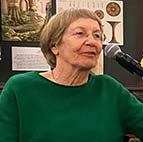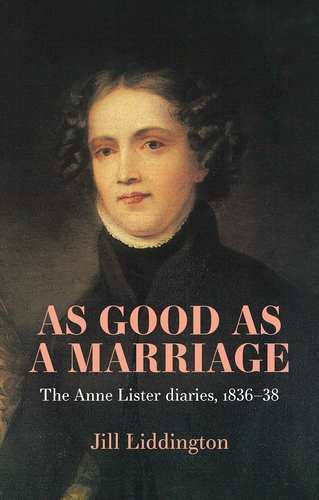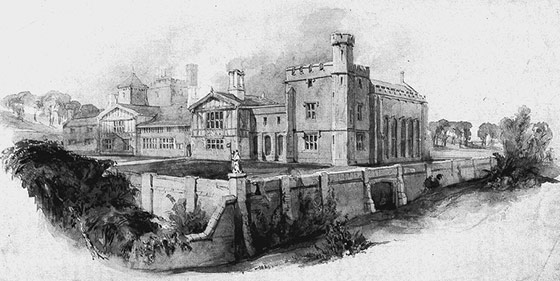

As Good As A Marriage:
Anne Lister 1836-38
Anne Lister in 1836
Female Fortune, the book that inspired Sally Wainwright to write Gentleman Jack, ended in May 1836, just a month after the death of Anne’s elderly father. On Tuesday 10 May, the final diary entry, Anne and Ann, in York to get their lawyers to tidy up their wills, left the city and got back home at 11.20 am. That same day at 8.30 am, Anne’s sister Marian Lister had departed from Shibden to live in East Yorkshire. Anne had missed saying goodbye to the last of her immediate family by just three hours.

As Good As A Marriage is the sequel to Female Fortune. These two years, May 1836 to May 1838, have been rather neglected by earlier editors, often because now wearied by transcribing, they tended to scurry over Anne’s last few years. Yet these years are crucial to our understanding of Anne and Ann’s daring marriage, solemnized at Goodramgate Church in York in 1834.
Anne’s beloved Aunt Anne, now infirm, was virtually bedridden. She died on 10 October. Anne wrote with feeling in her diary: ‘My aunt is the last of [that] generation. She was always good and kind to me – none will ever think so highly of me – none was more interested in my interest – none… I thought till the tears started’. Anne then went and sat by Ann Walker, writing letters ‘with less ease because she talked to me’. The first letter was to Lady Stuart, the second to Mariana Lawton, the woman closest to her in her life, and only then to her sister Marian, a poor third in the correspondence. Anne then began organising the funeral: the list, with coffin-bearers and mutes (professional funeral attendants), ran to four pages long. Yet she gave no encouragement for Marian to attend.
So, by autumn 1836 Anne and Ann had lived together at Shibden for 2½ years. And now (apart from their servants) they were completely on their own. Like any settled couple, they enjoyed convivial evenings by the Shibden fireside. They would read together, either the newspaper or one of the latest books; they would talk, perhaps about Anne’s plans to ‘get off’ (i.e.travel abroad); and each would write their diaries. For, yes, Ann regularly wrote her journal during these two years (though as yet, sadly these volumes have not yet been discovered).
Anne’s daily diary entries would often begin ‘No kiss’, (no orgasm). But, sometimes aided by Ann’s glasses of wine, they did enjoy their time in bed together. For instance, in June 1836, Anne wrote:
Monday 6. Found her at luncheon fretting at having taken more wine after I left her… She has had three or four glasses, & so much is too much. Poor thing. What a waste of happiness… We must get off.
Tuesday 7. No kiss. But a very [good] attempt at play last night, & [at] grubbling [caressing] this morning - she owning that it was not that she disliked it, or that she did not like me, but she thought it wrong.
So why ‘wrong’? My understanding is that it stemmed from their religious beliefs. Both were devout Anglicans, always attending church for Sunday afternoon service; or, if that were not possible, reading the service at Shibden to the household servants. However, Anne firmly believed that God had created her Nature and that her sexuality was as He intended. Ann Walker, on the other hand, was far more conventional – and certainly experienced sexual guilt.
Unlike in the early 1830s, wooing of Ann was no longer required. Indeed, the coded passages during these two years, while still recording their relationship in intimate detail, often detail tensions, silences and quarrels. There was tremendous emotional volatility in their daily lives. For theirs could never be a conventional marriage. A lesbian union was recognized by neither church nor state. Nor were there any etiquette guides offering advice on how to conduct their relationship at home, with family or in public. And indeed many of Ann Walker’s innumerable relatives – the Rawsons down in Halifax, the William Priestleys in nearby Lightcliffe - remained highly suspicious about exactly what was going on up at Shibden. And who was paying for it.
Their quarrels were often about money. Ann had inherited considerable wealth on the death of her brother, and now owned half the great Crow Nest estate. She regularly received substantial rents from tenants; the rentals Anne received, even after the deaths of her father and aunt, were limited by comparison. Ann was generous to Anne with loans or gifts. Yet Anne had developed expensive tastes and remained keenly ambitious to glorify her Shibden. The Hall itself must no longer be just an old-fashioned farmhouse. A west tower must be built, along with an elegant terrace along the front so that Anne and Ann could walk on the elegant stone flags on a summer evening without getting their feet wet.

Shibden Hall, 'Perspective View: Garden Front', 1836, drawn by John Harper
(SH:2/M/2/1) West Yorkshire Archive Service, Calderdale
And they must have more servants. Including, of course, a footman and a groom, both requiring appropriate livery. And they must have a wine cellar. Which was soon filled with expensive wines, bought in York, and carried up from Halifax by a poor one-horse cart, trudging up Old Bank – the very steep hill to Shibden. Anne also would develop her coal mining at Listerwick; and down in Halifax convert Northgate to a hotel, aiming to make both profitable.
For Anne, this was merely to fulfil her dynastic destiny. For Ann, such extravagant expenditure was far, far more difficult. After all, did Shibden feel like ‘home’ for her? Possibly not? Anne was unsympathetic about this, and in May 1837, she wrote candidly:
Friday 12.What a temper she has… How can I ever do with her in society? A vulgar pride is at the bottom of it. The beautifying of poor old Shibden may eclipse Cliff Hill. She is jealous of her authority, or rather of an importance which she knows not how to support. I must do the best I can.
Worse still was when Anne requested that Ann pay for the Shibden household expenses plus their travel. In October 1837, Anne wrote:
Sunday 21.On going to bed last night, A- seemed not against going to Paris for a month after Christmas, but had asked where the money was to come from…
I saw all was not right at breakfast… How all this pothers me! I have several times laughed & said she must… allow me a thousand a year for everything. She has never said she would. Says nothing on the subject…. Why should I be so pothered? Can solitude or anything be worse?... I feel in thraldom… I am better for writing my journal.
The ‘thousand a year’ demand rankled bitterly. Yet when they were away from Shibden, their relationship grew much warmer again. Anne was not then focused on estate business and Ann less tearful – when they took a trip up into the Yorkshire Dales or out to France. Indeed, As Good As A Marriage ends in August 1838 – with their travelling to Paris and then heading far south. Here, Anne climbed Vignemale, the highest mountain peak in the French Pyrenees. A magnificent achievement, a pioneer woman mountaineer!
Earlier, in 1832, when wooing and seducing, Anne Lister had recorded in code that Ann Walker had said of their union: ‘It would be as good as a marriage’. ‘Yes’ [replied Anne], ‘quite as good or better’.
So was it? It was certainly a volatile relationship. Partly because it was a dissident marriage. They were both out in the world without a script. Anne could sometimes write cruel words about Ann: ‘She wanted a good whipping… I told her I must buy a rod’. Yet there is of course no diary record of her doing this. Indeed the day, 30 July 1837, ended with domestic tranquillity, Ann’s young niece who was visiting Shibden being towed on a handmade raft along the meer at Shibden.
Then soon after, the 1837 General Election united Anne and Ann against a common enemy: the Whigs and the Radicals. For as local landowners they could doorstep their tenants to ‘persuade’ them to vote Blue (i.e. for the Tory candidate, now called Conservative). Women of course didn’t have the vote then. But, with no secret ballot yet, that mattered little.
For then, within a conventional marriage, wives had precious little authority or freedom. Divorce of even a coercive husband was nigh impossible. The infant Custody Bill, allowing a wife custody of her young child, only became law in 1839. And it was not till the 1850s that married women’s property laws were even considered, provoking strong opposition that this would destroy the sanctity of the home.
Anne Lister’s coded language about Ann might seem harsh; but often the quarrels fell away quickly and they enjoyed each other’s companionship. And Anne’s behaviour had nothing of the cruelty or infidelity experienced by Helen Huntingdon, abused wife in Anne Bronte’s novel, The Tenant of Wildfell Hall, (1848) written within a few miles of Halifax. Indeed, when even Mariana visited Shibden in November 1836, Anne chastely rebuffed M-‘s attempts at ‘open-lipped kisses’.
Long after her death in 1840, there is much to celebrate in both the life and diaries of Anne Lister. She courageously, though discreetly, lived a lesbian life at Shibden in the 1830s. And industrializing Halifax was not York nor London, let alone Paris! Yet, thanks to her diaries, we can now know, in graphic, intimate details, all about it.
So, if you watched Gentleman Jack, and wondered what Anne Lister did next, this sequel is your perfect next read!
If you'd like to know more, watch Jill discuss her new book As Good As A Marriage: the Anne Lister diaries 1836-38 in her MUP author video here. Recorded and edited by Rachel Lappin in the Book Corner at Halifax Piece Hall.